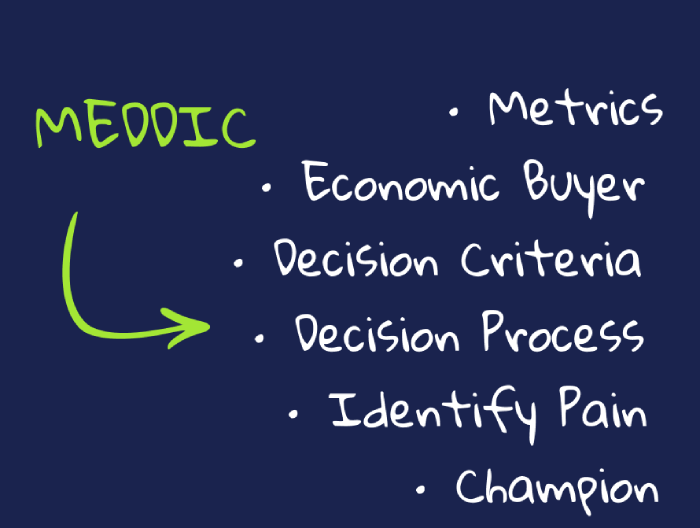
MEDDIC is a sales process framework that helps companies identify and qualify potential customers.
It is often used in B2B sales and is known to be effective in complex sales environments such as enterprise software, technology and services sales.
It is often used as a pre-sales qualification process, allowing the sales team to identify the best opportunities and focus their efforts on the most promising prospects.
Refers to the financial and quantitative measures that a customer uses to define success. These metrics can include things like revenue, profit, market share, or customer satisfaction.
In the context of the MEDDIC process, understanding a customer's metrics is critical because it helps sales teams understand what the customer is trying to achieve. By understanding the customer's metrics, sales teams can tailor their solution to align with the customer's goals and objectives. This can make the sales process more effective, as it demonstrates that the solution is directly relevant to the customer's needs.
For example, if a customer's metric is to increase revenue, a sales team might position their solution as a way to help the customer acquire new customers or increase sales from existing customers. On the other hand, if the customer's metric is to reduce costs, the sales team might position their solution as a way to help the customer streamline operations and reduce expenses.
Represents the individual or individuals within an organization who have the authority to approve the purchase and budget, and understanding who the economic buyer is, is critical for sales teams to align their solutions with the decision maker's needs, goals and objectives and tailor their sales approach accordingly.
For example, if the economic buyer is the CFO, the sales team might position their solution as a way to help the organization save money or generate a return on investment. On the other hand, if the economic buyer is the CEO, the sales team might position their solution as a way to help the organization grow revenue or gain a competitive advantage.
Represents the factors that the customer uses to evaluate solutions and vendors and understanding these decision criteria is critical for sales teams to align their solutions with the customer's needs, goals and objectives, identify potential pain points and tailor their sales approach accordingly.
For example, if price is the most important decision criteria, the sales team might position their solution as a cost-effective option. On the other hand, if performance is the most important decision criteria, the sales team might position their solution as a high-performing option.
Refers to the stages that the customer goes through to make a purchase. These stages can include identifying a problem or need, researching solutions, evaluating options, and making a decision. By understanding the customer's decision process, sales teams can tailor their sales approach to align with the customer's needs, goals and objectives. This can make the sales process more effective, as it demonstrates that the solution is directly relevant to the customer's needs.
For example, if the customer's decision process is to research solutions first, the sales team might focus on providing educational resources or informational materials. On the other hand, if the customer's decision process is to make a quick decision, the sales team might focus on providing a clear, concise presentation of their solution.
Refers to the specific problems or challenges that the customer is facing. Identifying the customer's pain points helps sales teams understand what the customer is trying to solve and what their needs are. By understanding the customer's pain points, sales teams can demonstrate that their solution is directly relevant to the customer's needs, which can make the sales process more effective.
For example, if a customer is struggling with high turnover, the sales team might position their solution as a way to improve employee retention. On the other hand, if a customer is struggling with low productivity, the sales team might position their solution as a way to improve productivity. In addition, identifying the customer's pain points can also help sales teams identify potential areas for improvement. For example, if a customer is struggling with high turnover, this may be an indication that the customer is struggling with employee engagement. Understanding this pain point can help the sales team position their solution as a way to improve employee engagement.
In the MEDDIC framework refers to an individual or group who acts as a supporter for the solution within the customer's organization, helping to move the sales process forward and increase support.
Identifying the champion is essential for sales teams as it allows them to identify the key internal stakeholders for the sale, and adjust their sales approach to align with the champion's goals, needs and objectives. This can make the sales process more successful as it shows that the solution is relevant to the champion's needs. For instance, if the champion is a department manager, the sales team can position their solution as a way to improve the department's efficiency, if the champion is the CTO, the sales team can position their solution as a way to enhance the organization's technology infrastructure.